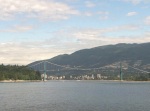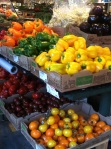- Siwash Rock
- Girl in a Wetsuit
- Boat House
- Lions Gate Bridge
- Brockton Point Lighthouse
Stanley Park in Vancouver is a delight, a joyride for a bicyclist. I rented a bike from a nearby shop and took off on a counter clockwise path that traces the seawall. The 9 km ride was so much fun that I did it a second time. The trail goes by several landmarks, including a 1972 sculpture that is Vancouver’s version of Copenhagen’s Little Mermaid: Girl in a Wetsuit. The path passes by Brockton Point Lighthouse, gives a glorious view of Lions Gate Bridge high overhead, and reveals Siwash Rock around a bend. The Nine O’Clock Gun occurs early in the path, a cannon placed in the 1890s, and shot at nine pm each night so that ships could set their chronometers.
Nine O’Clock Gun is also the title of two novels, the first written by Roland Wild (1952) and a more recent gumshoe detective novel by Jim Christy (2008). 
The book by Wild begins with 80-year-old Neil McKay, a Scottish immigrant, reflecting on his life in Vancouver from the late 1880s to post-World War II. In so doing, he traces the history of the city from its start as Gastown (created by “Gassy” Jack), then to Granville, and finally to Vancouver. Ever wonder why Vancouver is not on Vancouver Island? Blame the owners of the Canadian Pacific Railroad. When they pushed the transcontinental railroad through, the government of British Columbia acceded to their wishes to rename the city for Captain George Vancouver, much to the dismay of the inhabitants of Vancouver Island, already named for the 18th century explorer.
- Gassy Jack Statue in Gastown
- Steam-powered Clock
Wild’s novel begins on Howe Street; as it happened, I stayed in a hotel located on the same avenue. Recognition of places within a narrative is one of the real treats of reading literature set in the locales where one travels. The statue of Gassy Jack and the Steam-Powered Clock in Gastown mean more after reading pleasurable titles set in the area.
- Beer Bike – Granville Brewing
- Public Market – Granville Island
- False Creek Ferries
Granville’s name resides now on an island, where a fabulous public market offers local food, arts, and crafts. Another Granville is the main character in The Silk Train Murder (Klondike Era Mystery Series, 2007) by Sharon Rowse. Set in 1899, it features a little known historical factoid, that the silk imported from China to make its way to the eastern seaboard was more valuable than gold and required special train cars for transport—trains that needed protection, and thereby hangs the tale.
For a more contemporary look at Vancouver, read Stanley Park (2001) by Timothy Taylor, that follows the trials of chef Jeremy Papier, whose new restaurant Monkey’s Paw Bistro is on the brink of financial ruin. Surely Kiwi Frederique, a bleeding-edge restaurant critic who appears late in the narrative, is one of the best creations by a novelist. Taylor’s satiric and often comic critique of contemporary cuisine is biting and fun. A subplot involves Jeremy’s anthropologist father, who is living in Stanley Park to study the homeless. Yet another subplot focuses on the unsolved murder of two children whose bodies were uncovered in the park.
Vancouver offers much to see and do: take the charming ferries on False Creek from the city to the market on Granville Island; visit the Museum of Anthropology at the University of British Columbia to view the grand totems and Bill Reid’s wonderful centerpiece sculpture of Raven creating the world; follow up with a visit of Reid’s Art Gallery downtown (readers can see his illustrations in Raven’s Cry, a novel by Christie Harris about the Haida of Queen Charlotte’s Island); dine at one of the many restaurants in Yaletown. 
Two used bookstores deserve mention: MacLeod’s and the Paper  Hound, both with helpful staff, and both located on Pender Street. The street is also home to the charming Umbrella Shop (with two other locations, one on Granville Island). In business since 1935 in a city where people own multiple umbrellas, The Umbrella Shop is a delightful stop
Hound, both with helpful staff, and both located on Pender Street. The street is also home to the charming Umbrella Shop (with two other locations, one on Granville Island). In business since 1935 in a city where people own multiple umbrellas, The Umbrella Shop is a delightful stop . And then there is Weeds, a chain store devoted to the bud.
. And then there is Weeds, a chain store devoted to the bud.
Walking the streets of Vancouver or biking its 28 km seawall are enhanced by reading these novels to get a sense of its past and present. For more great reads set in Vancouver, check out this article, “Top Ten Books about Vancouver,” by George Fetherling, Vancouver Sun, April 8, 2011: http://www.vancouversun.com/news/books+about+Vancouver/4524537/story.html. Next up on my reading list: Legends of Vancouver by E. Pauline Johnson, a free e-book that recounts Squamish legends in the prose of the time (1911).











